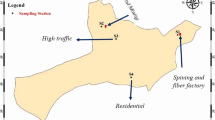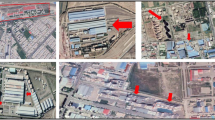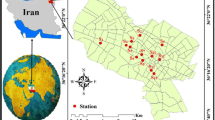Abstract
The aim of current research was to determine airborne asbestos fiber concentrations in the ambient air of Tehran, and to investigate their spatial distribution, seasonal variation, and human health risk assessment. For this, the sampling of the study was carried out during August 2017 and June 2018, and totally, 64 samples were taken from 8 stations along the different areas of Tehran. The concentrations of airborne asbestos fibers were determined by phase contrast microscope (PCM) and scanning electron microscopy (SEM) analyses. Spatial mapping was conducted using the inverse distance weighting (IDW) technique. The health risk assessment was done based on the detected levels of airborne asbestosis fibers. The mean concentrations of the airborne asbestos fiber were 1.9 × 10−3 f/ml and 595 × 10−3 f/ml based on PCM and SEM analyses, respectively. One of the effective factors on ambient level of asbestos fibers is meteorological parameters, where the maximum and minimum concentrations of asbestos fibers are related to cold and warm seasons, respectively. These differences could be due to the presence of inversions phenomenon in cold seasons in Tehran. It was observed that the excess lifetime cancer risk (ELCR) calculated for all the sampling areas are between 5.26 × 10−5 and 5.37 × 10−4. Based on the EPA-suggested standards (10−4–10−6), these values are categorized rather to moderate levels. The obtained data indicated no threat of asbestos fibers to Tehran’s citizens’ health.





Similar content being viewed by others
References
Abbasi F, Pasalari H, Delgado-Saborit JM, Rafiee A, Abbasi A, Hoseini M (2020) Characterization and risk assessment of BTEX in ambient air of a Middle Eastern City. Process Saf Environ Prot 139:98–105
Baghani AN, Rostami R, Arfaeinia H, Hazrati S, Fazlzadeh M, Delikhoon M (2018) BTEX in indoor air of beauty salons: risk assessment, levels and factors influencing their concentrations. Ecotoxicol Environ Saf 159:102–108
Bayat R, Ashrafi K, Shafiepour Motlagh M, Hassanvand MS, Daroudi R, Fink G, Künzli N (2019) Health impact and related cost of ambient air pollution in Tehran. Environ Res 176:108547
Cancer, I. A. f. R. o (1977) IARC monographs on the evaluation of carcinogenic risk of chemicals to man, vol 14. Asbestos
Commins B (1985) The significance of asbestos and other mineral fibres in environmental ambient air. Commins Associates, Kenilworth
Environmental Protection Agency U (1986) Guidelines for carcinogen risk assessment. Federal Register 51:33–1034
Faigout D (1985) Environmental release of asbestos from commercial product shaping. Project Summary. Environmental Protection Agency, Research and Development, Research Laboratory Cincinnati, OH, 45268
Faridi S, Niazi S, Yousefian F, Azimi F, Pasalari H, Momeniha F, Mokammel A, Gholampour A, Hassanvand MS, Naddafi K (2019) Spatial homogeneity and heterogeneity of ambient air pollutants in Tehran. Sci Total Environ 697:134123
Gualtieri AF, Mangano D, Gualtieri ML, Ricchi A, Foresti E, Lesci G, Roveri N, Mariotti M, Pecchini G (2009) Ambient monitoring of asbestos in selected Italian living areas. J Environ Manag 90(11):3540–3552
Jiang GC et al (2008) A study of airborne chrysotile concentrations associated with handling, unpacking, and repacking boxes of automobile clutch discs. Regul Toxicol Pharmacol 51(1):87–97
Kakooei H, Marioryad H (2010) Evaluation of exposure to the airborne asbestos in an automobile brake and clutch manufacturing industry in Iran. Regul Toxicol Pharmacol 56(2):143–147
Kakooei H, Normohammadi M (2014) Asbestos exposure among construction workers during demolition of old houses in Tehran, Iran. Ind Health 52(1):71–77
Kakooei H et al (2007) Asbestos exposure during routine brake lining manufacture. Ind Health 45(6):787–792
Kakooei H et al (2009) Assessment of airborne asbestos fiber concentrations in urban area of Tehran, Iran. Air Qual Atmos Health 2(1):39
Kakooei H, Meshkani M, Azam K (2013) Ambient monitoring of airborne asbestos in non-occupational environments in Tehran, Iran. Atmos Environ 81:671–675
Khadem M, Somea MS, Hassankhani H, Heravizadeh OR (2018) Joint Iranian-Russian studies of airborne asbestos concentrations in Tehran, Iran, in 2017. Atmos Environ 186:9–17
Khamutian R et al (2015) The association between air pollution and weather conditions with increase in the number of admissions of asthmatic patients in emergency wards: a case study in Kermanshah. Med J Islam Repub Iran 29:229
Lajoie P, Q. M. d. l. s. e. d. s. sociaux (2005) Asbestos fibres in indoor and outdoor air: the situation in Quebec. Institut national de santé publique du Québec, Montréal
Lim H-S et al (2004) Airborne asbestos and non-asbestos fiber concentrations in non-occupational environments in Korea. Ind Health 42(2):171–178
Malek E, Davis T, Martin RS, Silva PJ (2006) Meteorological and environmental aspects of one of the worst national air pollution episodes (January, 2004) in Logan, Cache Valley, Utah, USA. Atmos Res 79(2):108–122
Marioryad H, Kakooei H, Shahtaheri SJ, Yunesian M, Azam K (2011) Assessment of airborne asbestos exposure at an asbestos cement sheet and pipe factory in Iran. Regul Toxicol Pharmacol 60(2):200–205
Miri M, Rostami Aghdam Shendi M, Ghaffari HR, Ebrahimi Aval H, Ahmadi E, Taban E, Gholizadeh A, Yazdani Aval M, Mohammadi A, Azari A (2016) Investigation of outdoor BTEX: concentration, variations, sources, spatial distribution, and risk assessment. Chemosphere 163:601–609
Mokhtari M, Jafari N, Mohammadi A, Hajizadeh Y, Ghanbari R, Nemati S, Abdolahnejad A (2019) Temporal and spatial trends of airborne asbestos fiber concentrations in the urban areas of Yazd, Iran. Int J Environ Sci Technol 16(6):2657–2666
Moteallemi A, Minaei M, Tahmasbizadeh M, Fadaei S, Masroor K, Fanaei F (2020) Monitoring of airborne asbestos fibers in an urban ambient air of Mashhad City, Iran: levels, spatial distribution and seasonal variations. J Environ Health Sci Eng 18(2):1239–1246
Mullaugh KM, Hamilton JM, Avery GB, Felix JD, Mead RN, Willey JD, Kieber RJ (2015) Temporal and spatial variability of trace volatile organic compounds in rainwater. Chemosphere 134:203–209
Naghavi M (2005) Iranian annual of national death registration report. Iran Ministry of Health and Medical Education, Tehran
Napolitano A, Pellegrini L, Dey A, Larson D, Tanji M, Flores EG, Kendrick B, Lapid D, Powers A, Kanodia S, Pastorino S, Pass HI, Dixit V, Yang H, Carbone M (2016) Minimal asbestos exposure in germline BAP1 heterozygous mice is associated with deregulated inflammatory response and increased risk of mesothelioma. Oncogene 35(15):1996–2002
Pastuszka JS (2009) Emission of airborne fibers from mechanically impacted asbestos-cement sheets and concentration of fibrous aerosol in the home environment in Upper Silesia, Poland. J Hazard Mater 162(2-3):1171–1177
Pawełczyk A, Božek F (2015) Health risk associated with airborne asbestos. Environ Monit Assess 187(7):428
Sullivan JB, Krieger GR (2001) Clinical environmental health and toxic exposures. Lippincott Williams & Wilkins, Philadelphia
Walton W (1982) The nature, hazards and assessment of occupational exposure to airborne asbestos dust: a review. Ann Occup Hyg 25(2):117–119
Wei B et al (2012) Airborne crocidolite asbestos fibers in indoor and outdoor air in a rural area, China
WHO (2000a) Asbestos. Air quality guidelines, 2nd edn. WHO Regional Office for Europe, Copenhagen (Chapter 6.2)
WHO ( 2000b) Air quality guidelines for Europe, 2nd edn. WHO Regional Publications European Series, No. 91
Funding
For this study, the authors received financial and technical support (Grant No. 96-02-212-31563) from Iran University of Medical Sciences.
Author information
Authors and Affiliations
Corresponding authors
Ethics declarations
Conflict of interest
The authors declare that they have no competing interests.
Additional information
Responsible Editor: Amjad Kallel
Rights and permissions
About this article
Cite this article
Kermani, M., Jafari, A.J., Gholami, M. et al. Concentrations, spatial distribution, and human health risk assessment of asbestos fibers in ambient air of Tehran, Iran. Arab J Geosci 14, 1929 (2021). https://doi.org/10.1007/s12517-021-07149-5
Received:
Accepted:
Published:
DOI: https://doi.org/10.1007/s12517-021-07149-5




